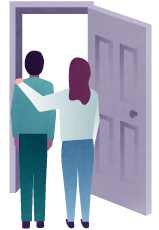Overcoming Trauma and PTSD Associated with Physical Spaces

Just two weeks after one of the deadliest school shootings in U.S. history, 3,000 students at Marjory Stoneman Douglas High School returned to class. Roughly 95 percent of students returned to the campus where they witnessed 17 classmates shot to death and 14 others seriously injured. The first week, they were eased back into a school routine with half-day schedules, and were greeted by therapy dogs, mental health counselors and heavily armed police officers. Candles and teddy bears were placed in the seats of students whose lives were claimed by the gunman.
For many of those students, and those of the 102 other schools that experienced gun violence in 2018, school will never be the same. It will forever be associated with this traumatic incident. Although the building where the tragedy occurred remains closed, students who spoke about the incident one year later say they continue to experience recurring dreams about the shooting, feel nervous when they hear loud sounds in the hallways, have panic attacks, and are simply not able to make it through the school day.
Traumas can be brought on by any emotionally disturbing or distressing event, and each person recovers uniquely because they process the event through their own lens of personal experiences. For some, returning to a space where trauma occurred can evoke intense emotional and physiological reactions, so avoiding it may seem like an intuitive safeguard from further harm.
“People avoid other people, places or things that remind them of trauma, which is a result of feeling powerlessness, hopelessness and terror,” said Dr. Thema Bryant-Davis, faculty member with the OnlinePsychology@Pepperdine program.
However, avoiding those spaces may not be healthy in the long term, especially for those who are obligated to visit these places regularly—like a workplace or a campus—because it inhibits survivors from leading a full life. Working with a mental health professional to reenter physical spaces associated with trauma can be an important part of healing from the experience.
What is PTSD?
Post-traumatic stress disorder (PTSD) is a clinical, psychiatric disorder developed after a person of any age has experienced or witnessed a traumatic event. Trauma takes a variety of forms, but often involves experiencing a natural disaster, serious accident, terrorist act, combat in a war zone, rape, assault, or other act of violence, according to the definition of PTSD from the American Psychiatric Association.
Even though data from the National Center for PTSD shows that 50 percent of women and 60 percent of men experience at least one trauma in their lives, only about 7 percent to 8 percent of people in the U.S. develop PTSD. According to PTSD information from Anxiety and Depression Association of America, symptoms are categorized in three main ways:
Emotional numbness including avoidance of places, people and activities that cue feelings associated with the trauma.
Re-experiencing the traumatic event through recollections, flashbacks or nightmares.
Increased arousal such as difficulty sleeping and concentrating, feeling jumpy and being easily irritated or angered.
“One of the challenges for PTSD is that these symptoms have become so severe that they are affecting one’s ability to live a full life,” Bryant-Davis said. “So a person is living with limitations that are not based in actual danger.”
An overview on PTSD from the National Institute of Mental Health notes that a diagnosis of PTSD requires that an adult have each of the following symptoms for at least one month:
- One or more re-experiencing symptoms.
- One or more avoidance symptoms.
- Two or more arousal and reactivity symptoms.
- Two or more cognition and mood symptoms.
Trauma, Memory and Physical Spaces
The lasting effects of a traumatic experience can manifest physically and emotionally. It’s common for symptoms of PTSD to be referred to as a “triggered” emotion or feeling, but the term “trigger” can have different meanings when taken out of context.
Dr. Terence Keane, director of the National Center for PTSD, says instead of using the term “trigger,” he uses “cues in people’s lives that represent traumatic experiences.”
Cues can include a person who resembles an assailant, a building that looks like the place in which an attack occurred, or a terrain similar to an area of combat.
“The brain is built to keep us safe. The mind is on a lookout for warning signals, so that when we feel fear, it helps to mobilize us, and decide if we should fight or flee or freeze.”
“These cues cause people to be preoccupied or have physiological reactions because of associative learning,” Keane said. People may falsely identify danger in an environment or with people that remind them of a prior trauma.
How does this physically affect people? According to a 1994 study on memory published in the research journal Nature, when first exposed to a traumatic event, the brain releases norepinephrine, a hormone related to adrenaline that sparks an intense emotional reaction. Intense emotions cause the brain to store an adrenaline-charged memory long term, which can quickly be recalled when a person enters another setting that resembles the original trauma.
“The brain is built to keep us safe,” Bryant-Davis said. “The mind is on a lookout for warning signals, so that when we feel fear, it helps to mobilize us, and decide if we should fight or flee or freeze.”
Traumatic memories can be recalled by specific cues that may be associated with a physical space.
“Similar locations, similar smells, similar looks or lighting,” can all resemble aspects of a space where a trauma occurred, Bryant-Davis said.
The Road to Recovery
In the case of trauma, time alone doesn’t heal all wounds.
Patients may need to work with a mental health professional to identify effective strategies that can help them safely reenter spaces that may once have cued symptoms of PTSD.
“Though it’s healthy to look out for warning signs, the mind may see danger in a place where it’s not, as a result of an intense level of fear,” Bryant-Davis said.
This thought process often leads to avoidance, which may not be a healthy coping process in the long term.
Bryant-Davis says one strategy for people recovering from PTSD can be gradual exposure to spaces where a trauma occurred.
“We start with what may be the least anxiety-provoking, and work up to what may be the most anxiety-provoking,” she said.
Reentering Locations Associated with Trauma
Gradual exposure to a space where a trauma may have occurred


Look at a picture of the place.


Walk or drive past the place.


Walk up to the place but do not go inside.


Go inside with a friend or support person, breathe, and then leave.


Go inside with support person and stay for a few minutes.


Go inside and stay by yourself.
It can also be helpful to practice deep breathing or develop a mantra to keep calm, Bryant-Davis said.
Other coping strategies include:
- Progressive muscle relaxation: Tensing and relaxing one muscle group at a time to reduce rapid breathing and heartbeat, stress, stomach problems and headaches.
- Therapeutic breathing: Inhaling and exhaling when feeling stressed or anxious.
- Cognitive processing therapy: Making sense of traumatic memories by talking with a therapist about the events, which can help piece together disjointed memories.
In some instances, returning to a space associated with a trauma may not be safe or feasible for clients, in which case, gradual exposure is not necessary or effective for recovery.
“If the offenders or perpetrators are still there, and there has been no change on their end, then avoidance becomes necessary as a form of safety and self-care,” Bryant-Davis said.
Barriers to Getting Help
Many marginalized groups live with increased risk for trauma and barriers to mental health services.
“Along with being less likely to seek out mental health services, marginalized populations are more likely to prematurely terminate after a session or two,” Bryant-Davis said, “which decreases the efficacy of the intervention.”
A variety of social and environmental factors can limit access to quality mental health care:
Income
Access to a therapist or counselor can depend on income and quality of health care coverage, because many appointments incur specialist fees. In addition, low-income families may have trouble finding a location accessible by public transportation and may be unable able to take time off work for an appointment.
Race and ethnicity
Social stigmas exist in many ethnic cultures about seeking mental health care. Fear of discrimination by a provider can also prevent people from seeking help. “Even getting past the stigma and showing up for an appointment, they are likely to encounter culturally incompetent care from people who are not affirming, or respectful or knowledgeable of their experience,” Bryant-Davis said.
Gender
About 10 percent of women develop PTSD compared to 4 percent of men, according to the National Center for PTSD.In addition, women who open up about sexual traumas face fear of being shamed, isolated or not taken seriously.
Age
Children react to traumas differently than adults. “When people are exposed to trauma as children, it increases their risk for future trauma,” Bryant-Davis said. The National Institute of Mental Health says PTSD symptoms unique to children include:
- Wetting the bed after having learned to use the toilet.
- Forgetting how to or being unable to talk.
- Acting out the trauma during playtime.
- Unusual attachment to a parent or other adult.
Helping Others Help Themselves
There’s no universal solution for trauma recovery, but when possible, it’s helpful for those in need to be supported—emotionally, physically and mentally.
How to Care for Others
- Be physically present and available.
- Look for signs that someone might be feeling unsafe in a space.
- Learn symptoms and identify who to call in the case of an emergency.
- Ask what their needs are.
- Educate yourself about healthy coping styles.
- Be flexible and responsive to changing needs.
How to Care for Yourself
- Build safety and trust with peers.
- Have a trusted companion when entering a space.
- Practice a hypothetical narrative.
- Imagine a safe space during a time of stress.
- Monitor signs of stress or symptoms of PTSD.
- Change the setup or design of a space that cues traumatic memory.
“For so many people there’s an element of shame or embarrassment, which is a real problem for our society,” Keane said. “So making sure that people know they can talk about things is the best thing for others to offer.”
Where to Find Help
For immediate support and intervention, Call 1-800-273-8255 or go the website of the National Suicide Prevention Lifeline to speak to trained professionals who are available 24/7.
For help connecting with a mental health advocate, visit the following sites:
- American Psychological Association PTSD Guidelines for Patients and Families
- National Center for PTSD Self Help and Coping Resources
- Substance Abuse and Mental Health Services Administration Behavioral Treatment Locator
- S. Department of Health and Human Services Mental Health and Addiction Insurance Help
Note: This article has been published for informational purposes only and does not represent a medical opinion. If you or a loved one are exhibiting signs of PTSD or trauma, you should consult with a mental health professional.
Citation for this content: OnlinePsychology@Pepperdine, the Online Master of Psychology program from Pepperdine University.

